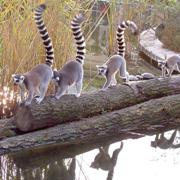Summer Nicks throws on some rainforest boots and binoculars and goes off in search of the camera-coy, long-limbed creatures rife to Madagascar, which are optimistically expected to outlast the island nation’s rapid course of rapid industrialisation
An elongated finger creeps out from under a grubby ledge. There is rustling from above and two fluffy nests wedged next to each other on a makeshift bough seem to shift. “Ah, yes. He is hungry,” says the wizened keeper, Jerome. We wait. The winter sun is hot on our backs, though the ground has barely thawed from an August night freeze. From elsewhere in the zoo, bizarre screeches and wails pierce the air. Jerome tentatively watches the wooden hatch window he has just unlatched. A slight movement: five digits, brown and spindly like E.T.’s, reach slowly for a piece of fruit. Then, a sudden flash: a brown furry head and darting honey-coloured eyes – and the vision is gone. My finger hovers over the camera button. “There!” whispers Jerome satisfactorily. I look at him, first in joy, then in bewilderment – then, I suppose, in disappointment: I have failed to capture my first encounter with a lemur. “Again?” he asks. I nod, and he dutifully presses his lips to make squeaky, lemur-like noises.
Jerome has been Head Lemur Keeper at Antananarivo Zoo (better known as Parc Zoologique Tsimbazaza) for decades. He knows every one of his charges, the majority of whom wander about happily in the moated enclosures scattered around this vast and scrubby zoo, which is devoid of western amenities and badly in need of funds. The hungry but paparazzi-shy creature has ducked below the ledge. Again, it reaches out with spidery fingers, but Jerome, who has coaxed many a lemur in his day, has smartly placed the fruit further away. Suddenly, eyes popping, mouth agape, beady pupils fixed on the morsel, the lemur appears. The shutter drops, and – despite a deep dislike of animal baiting, especially for photo ops – I’ve happily captured a priceless moment: a close encounter with a unique and fragile mammal.
Along with aye-ayes and chameleons, wild lemurs are found only in Madagascar. They come in all shapes and sizes, but it is the smaller ring-tailed lemur (Lemur catta), with its melee of animal and human slapstick movements (gambolling on four legs or bounding on two) that really attracts admirers, as I discovered at the Parc Anja Reserve, a small nature reserve just south of Fianarantsoa. Set up by a street kid-turned-eco-warrior, the Parc Anja Reserve rides on the support of volunteers from the far-from-affluent local community. At sunset each night, as dying winter rays cast shadows across boulder-strewn inselbergs (small ridges), locals and paying tourists gather to watch Parc Anja’s furry residents fly through the trees in a great flurry of grey fur, like demented spirits from some otherworldly place.
Through binoculars, one spots them leaping to incredible heights and then tiptoeing along boughs like a troupe of tightrope walkers. But I soon learnt that there is more to Madagascar’s environmental image than such splendid performances. Rich in minerals and gems and boasting excellent seafood and timber, Madagascar is attracting speculators from all corners of the world. Politics is pushing change. In the lead is a new and young entrepreneurial president – the former mayor of Antananarivo – who installed himself at the post after a brief political scuffle in 2002 – and again now in 2009. Recognising the value of Madagascar’s rich resources, businessman-president Marc Ravalomanana is keen to unshackle this impoverished nation from its former French colonial and Marxist ideologies, neither of which has brought the country nearer to anything other than the verge of collapse.
Of course, none of this interests the lemur, for whom a piece of pineapple holds more significance than politics. But perhaps it should: as the nation opens to tourism and foreign investment, its road, air and rail transportation systems – which were all but destroyed in inter-factional riots six years ago – are being refurbished by private, mostly international companies. Wildlife conservationists are wary of this industrial development, and bad press – about mining projects damaging ecosystems – abounds. Should prosperity come at a cost to its precious flora and fauna, Madagascar will face a situation with which conservationists in South Africa, Brazil, India, Sri Lanka and China are all too familiar. But here, the stakes are even higher: over 80 percent of the island’s plant species aren’t found anywhere else on earth. The island’s rare periwinkle, for example, used in traditional medicine, is almost extinct. The best way for tourists, businesses and the like to approach Madagascar? As you would a lemur: cautiously.





